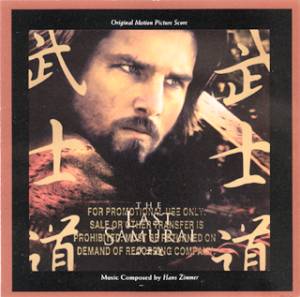The Last Samurai
Music composed, arranged and produced by Hans Zimmer
- Delores Clay – Vocals
- Craig Eastman – Fiddle
- Steve Erdody – Cello
- Benjamin Hale – Navajo Voices
- June Kuramoto – Koto
- Emil Richards – Taiko
- Bill Schultz – Shakuhachi
- Fred Selden – Flute & Ethnic Woodwinds
- Hans Zimmer – Synthesizers
Available on Elektra 62932-2
Running time: 59.47
Amazon UK Amazon US

It all begins with Legends of the Fall (1994), the would-be epic directed by Edward Zwick, photographed by John Toll, and with a puzzlingly inappropriate shakuhachi as a key element of James Horner’s nevertheless exceptional score.
It continues in 1999 with John Toll as the cinematographer on the second version of The Thin Red Line, for which Hans Zimmer provided the score, complete with appropriate shakuhachi. The resultant hour long album contained 11 generally lengthy, atmospheric, sometimes dreamlike cues mixing orchestra and electronics for an epic story of Americans fighting Japanese in the Pacific in WWII.
Now we have The Last Samurai, and Hans Zimmer’s hour long, 11 track album for Edward Zwick’s epic war film about an American in Japan, with cinematography by John Toll, and an entirely appropriate shakuhachi…
Those who know Zimmer’s Thin Red Line album will be in very familiar territory as they press play for the first time. The opening cue, "A Way of Life" is a slow burning, gradually building and emotive musical landscape which clocks in at 8 minutes (almost exactly the same length as the opener to The Thin Red Line, "The Coral Atoll") establishing an intense motif which will recur throughout the score, and which echoes the most powerful sequence from Red Line, ""Journey to the Line".
The Last Samurai is through, for all its expansive and dreamlike qualities, something more of an action score than its predecessor. The second cue, "Spectres in the Fog" ascends to a melodically and emotionally powerful peak of dramatic percussion fuelled action recalling the highly wrought and tortured music Horner provided for Legends of the Fall’s Great War battle sequences, though it must be said without providing anything quite so melodically memorable as did Horner. Track three, "Taken", continues in very much the same vein, so much so that, given the way the cues are sequenced together without a break, one might not notice the track change.
"A Hard Teacher" is an exercise in low key atmospherics, the mood being one of tranquillity and gentle romance, the orchestration including koto and ethnic woodwind lending a sense of Japan for Hollywood audiences even while the writing remains thoroughly Western in conception. "To Know My Enemy" takes the music into the darkly ethereal landscapes Zimmer explored in his score for John Boorman’s Beyond Rangoon (1995), the melodic material being clearly evocative of that fine early soundtrack. Deeply emotionally charged, this is music which suggests Zimmer is scoring the personal price, horror and consequence of war – as he attempted to do for the laughable cartoon treatment of US-Japanese conflict that was Pearl Harbour (2001) – rather than the outward kinetic fury and crowd-pleasing mayhem.
"Idyll’s End" is a string lament, elegiac and touching, transforming into music which presages battle with rhythms of increasing urgency. "Safe Passage" offers another intense setting of the main theme, followed by a reprise of what may be considered the love theme, again with koto, and this time with a greater sense of passion.
Matters come to a head with furious, monolith taiko beats in "Ronin", a comparatively brief action cue which takes the score close to the territory Zimmer himself has described as "Gladiator in Japan". Chanting warrior voices in "Red Warrior" overlay a further version of the main theme, before the cue explodes into full-blown relentless suspense-action writing, scoring which suggests the film may capture the epic power Legends of the Fall aimed for but never quite achieved.
"The Way of the Sword" does indeed fit the "Gladiator in Japan" bill, leaving one with the hope that The Last Samurai is actually a film which will build to an epic finale, rather than begin with a vast battle and become increasingly small in scale. Zimmer’s music does suggest we are due to see something truly grand and worthy of the use of the word "epic", music which follows grandiose conflict with a lengthy, stark emotional aftermath.
The album ends with "A Small Measure of Peace", the title of which suggests a hard won prize, the music continuing the sombre mood of the finale to "The Way of the Sword". There is a darkness and pain which implies a film which taking itself very seriously, the music being presumably a long and highly mournful end-title. If so one can presume The Last Samurai is a film little troubled by happy endings.
As a score we will have to wait to see the film to judge this music’s effectiveness. It may well prove to be a major score for a great film, but then a decade ago it would have been easy to assume from its superb trailer that Legends of the Fall was bound for glory. As an album The Last Samurai offers greater variety than did The Thin Red Line and should please fans of that score to a considerable degree. Others may find this effective and powerful, though given the near monothematic nature of the writing, could well wish it were a little shorter. Recommended for those looking for an emotional modern epic score, though not one to turn to for extended action writing. A rich and moving, if perhaps too expansive release.
Gary Dalkin
4
Return to Index